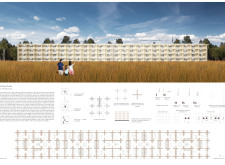5 key facts about this project
Modular Design and Community Interaction
The project employs a modular framework, enabling units to be arranged in various configurations. This structure not only enhances the spatial efficiency but also allows for the adjustment of unit sizes based on occupant requirements. The layout consists of single units, couple units, and family units, each designed with essential amenities to sustain comfortable living conditions. By promoting a grid-based design, the project creates opportunities for social interaction through shared communal areas, enhancing the sense of community among residents.
Sustainable Materiality
A significant aspect of The Green Puzzle is its focus on sustainability through the use of materials such as cross-laminated timber (CLT), integrated glazing systems, aluminum paneling, and reinforced concrete. CLT serves as the primary structural element, offering high durability and thermal insulation, which contributes to energy efficiency. Large windows integrated into the design maximize natural light, reducing the need for artificial lighting. The choice of materials not only minimizes the environmental impact of construction but also aligns with contemporary standards for energy-efficient living spaces.
Exploration of Architectural Elements
The architectural elements of The Green Puzzle are tailored to foster an engaging and functional living environment. The thoughtful arrangement of units facilitates a dynamic flow of movement within the building, while communal spaces are strategically placed to encourage interaction among residents. Each unit is equipped with functional areas that include kitchens and bathrooms, designed to meet the practical needs of occupants without compromising on comfort. This multifaceted approach to design encapsulates the project's aim of providing a holistic living experience for individuals and families alike.
For a comprehensive understanding of The Green Puzzle, including architectural plans, sections, and detailed designs, readers are encouraged to explore the project's presentation further. Delve into the architectural ideas that shape this innovative approach to affordable housing and gain deeper insights into its unique design strategies.























